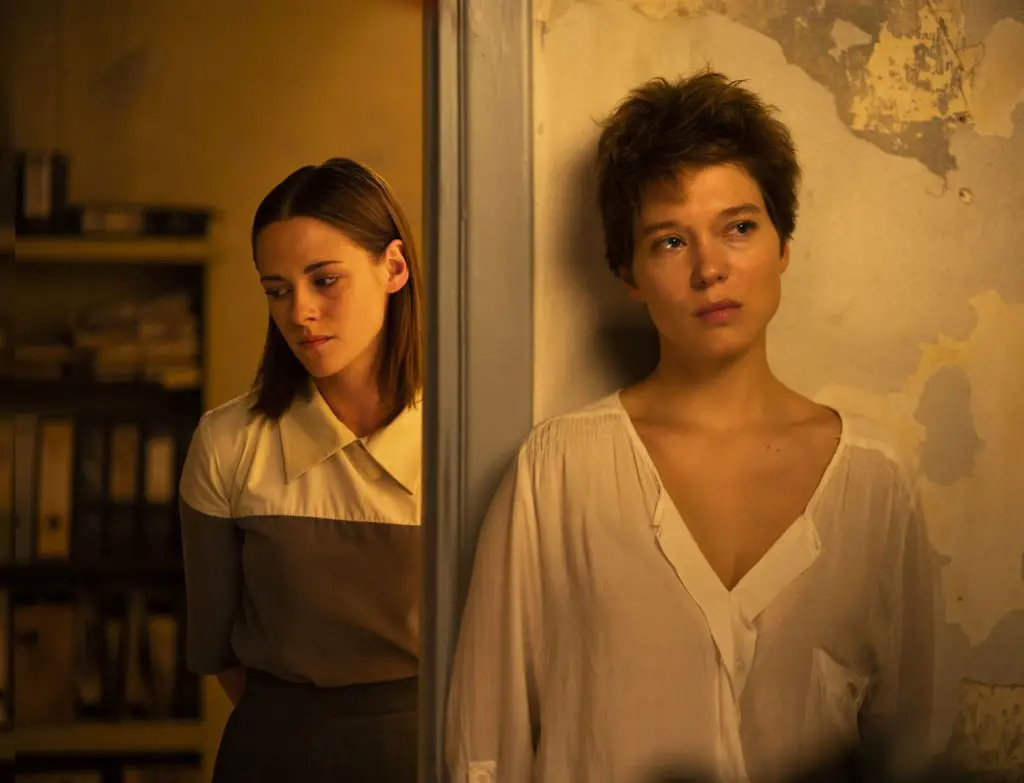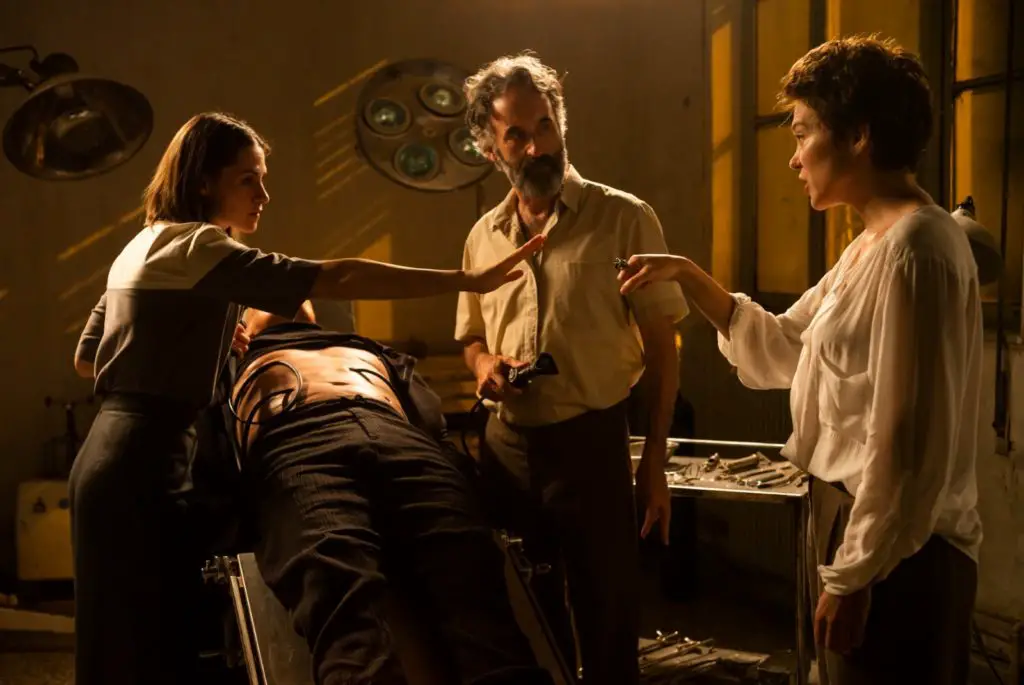Crimes of the Future (2022): the meaning of the film, the plot, the explanation of the ending, the description. Escape from yourself: what is the idea of the body horror “Crimes of the Future”.
Genre: fantasy, thriller
Year of production: 2022
Directed by: David Cronenberg
Cast: Viggo Mortensen, Léa Seydoux, Kristen Stewart
Awards and nominations: In 2022, the film was nominated for the Palme d’Or.
In mid-2022 at the Cannes Film Festival, David Cronenberg, an innovative and experimental filmmaker, founder of body horror, presented his new project, which returns to his early works. The director presented his interpretation of how the humanity of the future will adapt to the new synthetic environment. The point of Crimes of the Future is the impossibility of resisting evolution. However, this is only one of the layers of this strange, frightening picture.
What is the movie about
The script of the picture was written 20 years ago, but never got the implementation. For several years, the director carefully studied psychological motives, analyzing the lives of his characters, like a Gestalt therapist.
“Crimes of the Future”, despite futurism, does not show anything new and refers to the early, experimental work of the master. Embodying all the motives that sound throughout the director’s filmography, this film tells about a new world.
 Viggo Mortensen played the role of Saul Tenser. Frame from the film.
Viggo Mortensen played the role of Saul Tenser. Frame from the film.
Brief description of the content of the film “Crimes of the Future”. Near future. People experience accelerated evolution syndrome: they practically do not feel pain, and all sorts of injuries bring them pleasure. The cult of the body has taken on a new form: humanity has decided that inner beauty is more important than outer beauty. This new idea (the desire for inner beauty) was realized in the most direct sense.
The public is especially interested in body systems and various organs. The role of artists was tried on by surgeons. The main characters of the film, Saul Tenser, who suffers from accelerated evolution syndrome provoked by ecological collapse, and his muse, former surgeon Caprice, are the “stars” of body art.
Sol’s philosophy is simple. As a contemporary artist, he focused on creating art within himself. Somehow, his body began to grow new vestigial organs. They are incredibly strange: they have no function and most of all they look like creepy tumors.
He asks Caprice to cut out his “organs” and arranges a show from the operation, which is absorbed by the public with great pleasure. Moreover, the process of removing strange neoplasms is more reminiscent of public sex than a simple operation.
It seems to both the “creators” and the audience that everything that happens is imbued with a special secret meaning. He and Caprice register each new “organ” in Sol’s body with a special state department.
One day Saul, trying to find a new idea for his show, meets with a certain Lang Dotrice. He offers him a real sensation.
 Frame from the film.
Frame from the film.
It turns out that the new acquaintance is the leader of the “plastic eaters” – a group of people who voluntarily changed the digestive system by surgery. Now they are able to digest plastic.
Lang Dotrice tells the artist about his son, who was already born with a special digestive system, and invites him to publicly dissect the body. Saul likes the idea and agrees. However, special services intervene in the matter, seeking to control any changes of a biological nature. They sincerely do not want the world to know about the new stage of evolution…
Ending explanation
Toward the end, Saul, inspired by the ideas of the plastic eaters, decides to try eating one of the plastic bars offered to him by Lang. In the final, it becomes clear that after that it will be difficult for the artist to take ordinary human food.
Possible explanation for the ending: Sol will have to evolve further, join the plastic eaters and, possibly, become their leader in the future.
However, at the end of the film there are black-and-white shots: according to cinematic tradition, they appear posthumously. So whether Saul survived after the experiment is an open question.
However, his contented and peaceful face speaks in favor of the fact that he did not die. That is, we can assume that the experiment was a success: earlier, tumor organs grew randomly in him, but then he took the process under control. After meeting Dotrice, he became fascinated with a digestive system capable of processing plastic.
One day he mentioned that he was working on growing a new organ. It can be assumed that Saul grew a stomach that could handle plastic. He probably succeeded. The meaning of the ending of the film “Crimes of the Future” is probably that Saul has moved to a new level, that is, he has mutated.
The meaning of the film
At first glance, the film “Crimes of the Future” is more of a personal character. An aging performance artist who has created a new genre in film art observes people’s attempts to create.
Cronenberg is no longer able to surprise the viewer, and the last thing left for him to see the long-awaited body art is to cut his own body and take out the insides. The director primarily talks about himself, along the way touches on other topics that concern him and makes fun of the future, which, in his opinion, is capable of the most terrible crimes.
“Crimes of the Future” is a multi-layered picture. If we try to describe the essence of the film briefly, we can say that this is the director’s opinion about what a person can become by entering into a dialogue with his body – or vice versa, ceasing to control it. Its goal is not to scare, but simply to fix: if the body is not always you, but only a shell that knows how to suffer and enjoy, then what can it become in the future?..
The gloomy mind of David Cronenberg gives rise to strange fantasies. The world of the future for him is a vile and physiological world. People living in this world no longer dream of conquering space and beating cancer. Fed up with all sorts of entertainment, like the ancient Roman patricians, throwing up freshly eaten food to empty the stomach for a new meal, they found a new meaning for their existence in search of “inner beauty”.
 Kristen Stewart played the role of Leidou, Léa Seydoux as Caprice. Frame from the series.
Kristen Stewart played the role of Leidou, Léa Seydoux as Caprice. Frame from the series.
Trying to somehow exist in the world that has changed (probably after some kind of catastrophe), they move like dull shadows in the scenery of the post-apocalypse. Some revival occurs only during “performances”: when a thin scalpel opens a living body with surgical precision, the eyes of these people light up with interest and they begin to philosophize.
There is no pain in Cronenberg’s future. So, a person loses a sense of self-preservation. In an attempt to regain it, he goes under the knife. Human instincts are broken, feelings are confused, and the absence of physical pain is replaced by inner emptiness.
In their analysis, viewers note that all the characters in Cronenberg’s painting look alienated and lost. First of all, this applies to the main characters, although the rest of the characters, happily absorbing the content they offer, have long lost themselves.
“Crimes of the Future” is not a film for the average viewer, but for the audience of Cronenberg. This is a specific, personal and metaphorical picture with a veiled meaning. Trying to find a clue to everything that happens in the picture, we can assume that “The Crime of the Future” is a logical continuation of the ideas of “Existence” (one of Cronenberg’s early works). Except that in that picture, people fled from reality, integrating into the alien world of technology – here this flight continues, but on a different scale.
The virtual world is not enough and now people are trying to escape from themselves in our reality. According to the director, in the near future people will be born alien from the womb. As usual, he does not give a way out of the described horror.
According to one interpretation, the ideological basis of “Crimes of the Future” (as well as many other paintings by Cronenberg) is psychoanalysis. There is a reference in the film to the ideas of Jacques Lacan, who stated that “The body is reality.” If we take into account the ideas of psychoanalysis, we can assume that the hidden meaning of David Cronenberg’s latest work is that the world of the symbolic influences the Real so much that over time people will become walking simulacra.
 Frame from the film.
Frame from the film.
There is a lot of allegory in the film. The aging maestro is trying to adapt to the modern agenda, to understand and accept what is happening to all of us now. It is noteworthy that in the plot, rather gloomy at the very beginning, irony gradually appears.
It lies in the images of “plastic-eaters”, who voluntarily performed a number of complex operations in their bodies in order to be able to eat not organic food, but plastic. A wonderful allusion-parody of how artificial food we eat and at the same time enjoy it.
“We are what we eat,” Hippocrates once said. In the context of the film, this applies not only to food, but also to spiritual food. The film tells about the madness that occurs in modern society, gives another interpretation of the theme of an insatiable society.
The more a person gets pleasures and spectacles, the more he wants something new – tough, unexpected. Our excesses and unnecessary needs turn into a drug and gradually take over the mind. It is quite possible that in the future all this will only grow – and then you will have to look for more and more ways to satisfy your (more and more ugly) desires.
The film raises many important questions. Where is humanity going? Can you contain your impulses? How can we maintain our moral compass?
Cronenberg uses retrofuturism as an instrument of his creativity: in his world there are no mobile phones, but there are rather frightening automatic beds and eating appliances.
The director is trying to talk about many things: about a person’s search for new sensations, about an environmental problem and about the absurdity of modern art. His picture must be looked at carefully, without being distracted by trifles. There are no easy answers to the questions raised. But all the more interesting is the study of this unique world – and itself.
 Frame from the film.
Frame from the film.
Similar films
Here are a few films similar in meaning to Crimes of the Future:
- “Existence” (Canada, Great Britain, France, 1999). The heroes of the picture, participating in the development of a virtual game, are involved in its events in reality;
- Videodrome (Canada, 1983). Max Renn one day stumbles upon a TV program called Videodrome. The horrors that take place there cause him to lose touch with reality;
- “Fly” (USA, Canada, 1986). A talented scientist decides on a risky experiment. It changes not only his life, but also himself.







